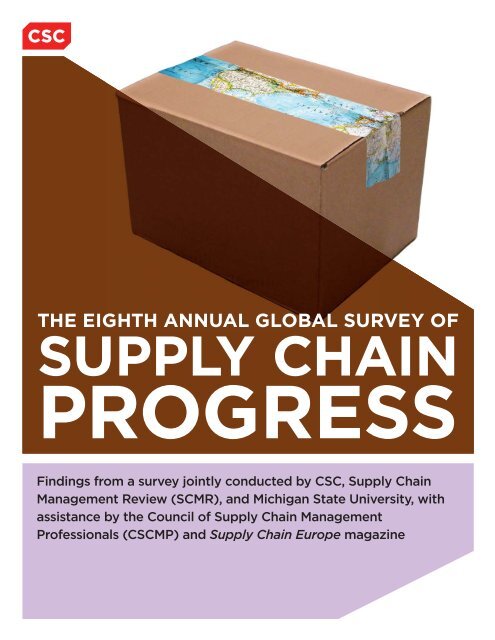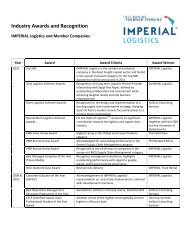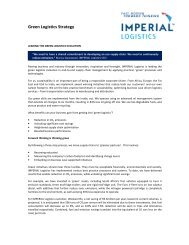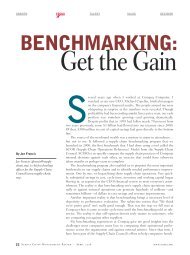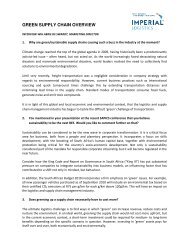Global Survey of Supply Chain Progress
Global Survey of Supply Chain Progress
Global Survey of Supply Chain Progress
You also want an ePaper? Increase the reach of your titles
YUMPU automatically turns print PDFs into web optimized ePapers that Google loves.
THE EIGHTH ANNUAL GLOBAL SURVEY OF<br />
SUPPLY CHAIN<br />
PROGRESS<br />
Findings from a survey jointly conducted by CSC, <strong>Supply</strong> <strong>Chain</strong><br />
Management Review (SCMR), and Michigan State University, with<br />
assistance by the Council <strong>of</strong> <strong>Supply</strong> <strong>Chain</strong> Management<br />
Pr<strong>of</strong>essionals (CSCMP) and <strong>Supply</strong> <strong>Chain</strong> Europe magazine
TABLE OF CONTENTS<br />
Sample Size and Details ................................................................................3<br />
Executive Summary ........................................................................................3<br />
Preliminary Conclusions................................................................................................4<br />
Key Findings ....................................................................................................................4<br />
Other Findings ................................................................................................................5<br />
<strong>Survey</strong> Analysis ................................................................................................5<br />
1. Business Impact on <strong>Supply</strong> <strong>Chain</strong> During<br />
the Economic Downturn ..........................................................................................5<br />
a. Increasing Emphasis on <strong>Supply</strong> <strong>Chain</strong> Efforts ..................................................5<br />
b. Products and Services ................................................................................................6<br />
c. Differences in How the Down Economy <br />
Affected Leaders and Followers ............................................................................6<br />
d. Impacts on Business Performance ........................................................................6<br />
2. <strong>Supply</strong> <strong>Chain</strong> Management Organization ............................................................9<br />
a. Leadership and Management Involvement ........................................................9<br />
b. Business Influence ......................................................................................................10<br />
c. Organization and Changes........................................................................................11<br />
d. Process Management..................................................................................................11<br />
3. Status <strong>of</strong> the Green <strong>Supply</strong> <strong>Chain</strong> ........................................................................11<br />
a. Organizational Approach to Evaluating<br />
and Implementing Initiatives ....................................................................................11<br />
b. Issues, Initiatives and Impacts ................................................................................12<br />
4. Procurement Initiatives ..........................................................................................13<br />
a. Sourcing Points and Re-Evaluation ......................................................................13<br />
b. Reactions to Economic Conditions ......................................................................13<br />
c. Critical Procurement Activities ..............................................................................13<br />
d. <strong>Global</strong> Network Results ............................................................................................14<br />
e. Future Focus..................................................................................................................15<br />
5. Demographics............................................................................................................15<br />
Patterns ............................................................................................................15<br />
Special <strong>Survey</strong> Details....................................................................................15<br />
The Renewed Call for Action ........................................................................15<br />
Conclusions......................................................................................................15<br />
The Eighth Annual <strong>Global</strong> <strong>Survey</strong> <strong>of</strong> <strong>Supply</strong> <strong>Chain</strong> <strong>Progress</strong> 2
Sample Size and Details<br />
The results <strong>of</strong> the eighth annual <strong>Global</strong> <strong>Survey</strong> <strong>of</strong> <strong>Supply</strong> <strong>Chain</strong> <strong>Progress</strong> are now<br />
available. The 2010 survey was conducted once again by CSC, <strong>Supply</strong> <strong>Chain</strong><br />
Management Review, The Eli Broad Graduate School <strong>of</strong> Management at Michigan<br />
State University, with assistance from the Council <strong>of</strong> <strong>Supply</strong> <strong>Chain</strong> Management<br />
Pr<strong>of</strong>essionals (CSCMP) and <strong>Supply</strong> <strong>Chain</strong> Europe magazine.<br />
This year’s survey attracted 164 complete responses, split evenly between<br />
manufacturing and service organizations. There were an additional 35 partial<br />
responses. The replies came from every major geographical segment in the<br />
world. The principal segments include North America, Europe, Asia/Pacific, and<br />
the rest <strong>of</strong> the world. Given these sample sizes, some approximate rules have<br />
been used to decide if differences between regions were statistically significant.<br />
In some sub-questions, the sample size is further reduced, and the rules have<br />
been modified to reflect the smaller sample size.<br />
The respondents completed a comprehensive survey questionnaire designed to<br />
gauge their present competencies and future plans in such areas as supply chain<br />
management policies and practices, supply chain continuity, and green and<br />
sustainability initiatives. The questionnaire specifically asked about results during<br />
the economic downturn. It particularly probed with regard to how supply chain<br />
initiatives and supply chain in general had played a role in reducing costs and<br />
sustaining revenues while impacting customers across the organization.<br />
Twenty industries were represented in this year’s survey, with twelve identified as<br />
containing manufacturing firms and eight representing service organizations. The<br />
respondents included both large and mid-sized companies, with sales in a range<br />
from $250 million to over a billion. The number <strong>of</strong> employees varied from less<br />
than 250 to over 30,000.<br />
There are general comments throughout the report, which relate to the differences<br />
between firms in North America, Europe and Asia-Pacific. These comments are<br />
based on the data set available and reflect our best estimate <strong>of</strong> the subsequent<br />
findings and conclusions, given the size <strong>of</strong> the sample <strong>of</strong> respondents. The total<br />
number <strong>of</strong> respondents is somewhat low when the data set is grouped into<br />
regions. Therefore, in terms <strong>of</strong> drawing statistically valid conclusions, there is a<br />
certain degree <strong>of</strong> vagueness which has to be accepted.<br />
Executive Summary<br />
This year, the respondents completed a comprehensive survey questionnaire<br />
designed to gauge their present competencies and future plans in such areas as<br />
supply chain management policies and practices, supply chain continuity, and<br />
green and sustainability initiatives. The questionnaire specifically asked about<br />
results during the economic downturn. We were also interested in what firms<br />
did during these times by introducing changes to organization structure and<br />
business focus.<br />
The first finding from the survey is that supply chain management (SCM) is<br />
now perceived by the vast majority <strong>of</strong> respondents as being <strong>of</strong> core business<br />
importance. There is also no question that during the recent economic downturn,<br />
companies turned to SCM for help. As might be expected, they did so while<br />
receiving a mixed bag <strong>of</strong> results with a fairly wide variation to impact on costs,<br />
revenues, internal adjustments and customer satisfaction. One <strong>of</strong> the differing<br />
results from previous surveys was a reported drop in the amount <strong>of</strong> overall cost<br />
savings coupled with lower increases to revenues. There were significantly less<br />
firms reporting the upper ends <strong>of</strong> cost and revenue benefits, while a much larger<br />
percent in 2010 said they had found no savings or were not able to report such<br />
benefits. Importantly, there was a sharp difference in performance between firms<br />
that considered themselves to be leaders in supply chain competence and others.<br />
<strong>Supply</strong> chain leaders and followers generated about the same levels <strong>of</strong> cost<br />
savings from their investments. However, leaders reported twice as much revenue<br />
gain as the followers.<br />
The Eighth Annual <strong>Global</strong> <strong>Survey</strong> <strong>of</strong> <strong>Supply</strong> <strong>Chain</strong> <strong>Progress</strong> 3
Firms apparently did what they must to hang onto the best customers, most<br />
likely acceding to pressures for lower prices. These customers were looking for<br />
external help, as they tried to use the recession to put their internal houses in<br />
order; that is, they applied pressure to suppliers for cost concessions, while also<br />
looking for supplier help combined with internal changes designed to cope with<br />
a difficult economy. Again, there was a sharp contrast in the ways that leaders<br />
and followers addressed these difficult times. Followers were more likely to scale<br />
back on product and service <strong>of</strong>ferings, whereas leaders were more likely to have<br />
reconfigured their global networks to adjust to changing conditions. Strategic<br />
flexibility is the hallmark competence <strong>of</strong> the supply chain leaders. Their abilities<br />
to anticipate and react to the dynamics <strong>of</strong> the downturn allowed them to<br />
weather, and in some case, thrive in tough times.<br />
Generally, it appears that buyers were able to get bargains as there were<br />
significant reports <strong>of</strong> costs being reduced on the buy side. At the same time, it<br />
was tough to be a supplier as the buyers were looking for lower costs along with<br />
supply chain help, particularly to product development and reducing cycle times.<br />
There were reports <strong>of</strong> some shifting in the customer base for firms, with leaders<br />
concentrating on shoring up market shares by satisfying the best customers,<br />
apparently taking shares away from less adept competitors.<br />
Green supply chain initiatives continued to show lukewarm results, with the<br />
positive improvements reported mainly by supply chain leaders. While, as a<br />
whole, respondents were somewhat skeptical <strong>of</strong> their green supply chain efforts<br />
so far, a significant number reported 3 to 4 percent annual savings, especially in<br />
areas <strong>of</strong> energy, transportation, and packaging.<br />
Preliminary Conclusions<br />
This year’s survey results suggest that most firms are at or near the bottom <strong>of</strong><br />
the economic trough and slowly coming back to more favorable conditions. As<br />
expected, the leaders are coming back faster than the followers and laggards.<br />
From other information we have used to augment our conclusions, we find hiring<br />
is still conservative and there continues to be a focus on cost reduction. Large<br />
companies remain conservative in their investments, foregoing new capital and<br />
concentrating on fixing existing capital. In that scenario, SCM becomes one <strong>of</strong><br />
the major means to find cost improvement — right behind reductions in staff.<br />
Thus there may be a conflict <strong>of</strong> purpose by reducing staff that disables some <strong>of</strong><br />
the ability to pursue cost reductions.<br />
Key Findings<br />
A few <strong>of</strong> the key findings include:<br />
• We observed the amount <strong>of</strong> cost savings reported, as the number <strong>of</strong> firms<br />
that reported no savings or not sure <strong>of</strong> savings rose from 13 percent in 2009<br />
to 20 percent in 2010. The firms reporting 11 to 20 percent savings fell from<br />
20 percent in 2009 to 10 percent in 2010.<br />
• We observed a reversal in previous trends in the reported revenue increases<br />
due to supply chain efforts. Firms reporting no increases or not able to find<br />
increases rose from 30 percent in 2009 to 47 percent in 2010. Clearly, the<br />
down economy took its toll on what had been consistent improvements in<br />
both areas — costs and revenues — for 7 consecutive years.<br />
• When asked what happened to the emphasis on SCM in the last 12 to 24<br />
months, 77 percent reported it had increased. Things might have been<br />
worse without SCM.<br />
• Typical <strong>of</strong> the mixed results in the down economy, when asked if the<br />
downturn had resulted in changes to cost <strong>of</strong> materials, 26 percent said they<br />
went up and 47 percent said they went down. Some companies must have<br />
found the way to use tough times to cut costs, while others were faced with<br />
adjusting to higher costs.<br />
• When asked if the downturn had resulted in changes to market share, 37.5<br />
percent said their shares had gone up, while 22.5 percent said they went<br />
The Eighth Annual <strong>Global</strong> <strong>Survey</strong> <strong>of</strong> <strong>Supply</strong> <strong>Chain</strong> <strong>Progress</strong> 4
down. Obviously, there was some shifting <strong>of</strong> the customer base, most likely<br />
to the firms able to <strong>of</strong>fer better pricing and service.<br />
• Other factors to be reported in this summary verify that SCM played an<br />
important role in at least keeping the lid on costs and helping revenue retention.<br />
Other Findings<br />
Other findings indicate a continued evolution in the role that SCM plays:<br />
• When asked if supply chain management was viewed as being <strong>of</strong> core<br />
importance to the business, 82 percent replied positively. When replying to<br />
the question <strong>of</strong> how much influence SCM has on running the business, 52<br />
percent replied to a great degree, and another 35 percent said to a<br />
moderate degree, leaving only 17 percent to ponder what effect SCM might<br />
have. Interestingly, 67 percent <strong>of</strong> European organizations feel that the SCM<br />
Organization (SCMO) have a great deal <strong>of</strong> influence in running the business,<br />
whereas this drops to 48 percent in North America.<br />
• From past surveys, we have found a direct correlation with good results and<br />
the presence <strong>of</strong> a supply chain <strong>of</strong>ficer directing the functions under the SCM<br />
umbrella. The SCM leadership’s relation to the CEO remained essentially<br />
unchanged: 53 percent in 2009 to 49 percent in 2010. We surmise some<br />
other <strong>of</strong>ficer subsumed SCM functions during the downturn. Forty-nine<br />
percent <strong>of</strong> the respondents did indicate the SCM <strong>of</strong>ficer reported directly to<br />
the CEO. In North America, 75 percent <strong>of</strong> organizations have a VP, Senior VP<br />
or Corporate Staff as the highest ranking <strong>of</strong>ficial with supply chain-related<br />
responsibilities, while in Europe, this figure is closer to 36 percent.<br />
• As we probed regarding the extent to which circumstances drove SCM<br />
organization changes, the top three responses were:<br />
– Change in leadership<br />
– Taking advantage <strong>of</strong> possible synergies<br />
– Structure was impeding strategies and achievement <strong>of</strong> objectives<br />
• It has been a tough year to be a supplier. There was clear evidence that<br />
companies relied more on suppliers to help with cost control, new product<br />
development and meeting customer demands. At the same time, there was<br />
continued expectation <strong>of</strong> finding better prices, or the buyer would shift its<br />
supply base. The key for suppliers was sustaining the most important<br />
customer base by <strong>of</strong>fering help in both areas.<br />
• Green issues continue to be a part <strong>of</strong> any emerging supply chain strategy,<br />
but the actual results have a wide variance with lukewarm results being the<br />
order <strong>of</strong> the day. For example, 72 percent reported that green initiatives had<br />
resulted in no revenue increases, while in regard to cost savings, 60 percent<br />
indicated savings from green initiatives from 1 to 11 percent.<br />
<strong>Survey</strong> Analysis<br />
The survey contained four major sections addressing the economic downturn,<br />
and resulting changes in supply chain organizational structures, green initiatives,<br />
and procurement initiatives. In this section <strong>of</strong> the report, we present detailed<br />
findings, along with some additional demographic information.<br />
1. Business Impact on <strong>Supply</strong> <strong>Chain</strong> During the Economic Downturn<br />
a. Increasing Emphasis on <strong>Supply</strong> <strong>Chain</strong> Efforts<br />
So what happened to supply chain efforts and results for the company during<br />
the economic downturn In the first place, we asked what happened to the<br />
emphasis on supply chain and received a resounding 78 percent reporting it had<br />
increased. SCM became a logical area <strong>of</strong> concentration to try and counteract the<br />
effects <strong>of</strong> the decline. Overall, we found the economic downturn caused firms to<br />
turn to its supply chain for help. In some cases, that posture was successful and<br />
in others there was an apparent lack <strong>of</strong> capability and costs were sustained<br />
rather than reduced and market shares declined.<br />
The Eighth Annual <strong>Global</strong> <strong>Survey</strong> <strong>of</strong> <strong>Supply</strong> <strong>Chain</strong> <strong>Progress</strong> 5
During the past 12 to 24 month<br />
economic downturn, what<br />
happened to the emphasis on<br />
supply chain improvements<br />
Increased in<br />
importance<br />
78%<br />
17%<br />
6%<br />
Remained<br />
the same<br />
Decreased in<br />
importance<br />
b. Products and Services<br />
When we asked about the impact on product and service <strong>of</strong>ferings, we were<br />
surprised to find 50 percent reporting no impact and another 21 percent saying it<br />
had little impact. It would appear that SCM was focused squarely on costs and<br />
internal improvements, with firms keeping the current <strong>of</strong>ferings as close to prime<br />
as possible. We went further and asked how you would rate the impact on new<br />
product introductions and again found most <strong>of</strong> the responses coming in on the<br />
down side.<br />
The need for greater logistics support came in with a bell-shaped curve and a<br />
generally normal distribution. Some firms sought help in this area while others<br />
stayed pat. The two areas receiving the most impact were the demand to<br />
shorten cycle times and the need for more help from sourcing and suppliers. This<br />
trend would be borne out throughout the survey as suppliers were expected to<br />
help pick up the slack due to lesser sales volumes. We did ask if there was an<br />
impact to the delivery <strong>of</strong> improved network design, but the answers were<br />
skewed to the low side.<br />
We asked specifically how the firms rated the impact <strong>of</strong> the downturn on sales<br />
and operations planning (S&OP). This has been an area <strong>of</strong> growing concentration<br />
in supply chain, especially for the leaders. Consistent with the messages<br />
delivered in 2010 was the fact that the most impact was to the “need for agile<br />
reaction to changes in customer demand,” with 66 percent reporting a moderate<br />
to high degree <strong>of</strong> impact. The second highest area was the need to better<br />
balance actual supply and demand. This requirement has also been receiving<br />
consistently higher emphasis as we conclude each annual survey. The third area<br />
was the need to use advanced planning tools. Other factors such as the need to<br />
rely on inventory to satisfy demand and application <strong>of</strong> inventory management<br />
tools to decrease inventory turns came in with moderate to low responses.<br />
Apparently, there was moderate emphasis on using the downturn to cut<br />
inventories, which is something <strong>of</strong> a surprise.<br />
c. Differences in How the Down Economy Affected Leaders and Followers<br />
Overall, supply leaders moved to a more strategic approach in dealing with the<br />
economic downturn. Their responses indicated that they had a greater capacity<br />
to anticipate the need for change.<br />
Our SCMO completely<br />
comprehends different issues or<br />
situations that may trigger the need<br />
for organizational structure change<br />
Our SCMO continuously analyzes<br />
pertinent information, including events,<br />
trends, and relationships, that may<br />
impact the organization structure<br />
Our SCMO effectively identifies<br />
organizational capabilities required to<br />
implement new SCM strategies or<br />
courses <strong>of</strong> action<br />
Our SCMO has a clear understanding<br />
how to redesign the organization to<br />
help build required organizational<br />
capabilities<br />
Leaders<br />
Followers<br />
0% 20% 40% 60% 80% 100%<br />
The Eighth Annual <strong>Global</strong> <strong>Survey</strong> <strong>of</strong> <strong>Supply</strong> <strong>Chain</strong> <strong>Progress</strong> 6
And the leaders were more adept at implementing needed changes.<br />
Our SCMO is able to effectively<br />
implement organizational<br />
structural changes<br />
Our SCMO can scale SCM<br />
operations to effectively match<br />
changing requirements<br />
Our SCMO responds effectively<br />
to the changing needs <strong>of</strong> our<br />
firm’s internal organizations<br />
Leaders<br />
Followers<br />
Our SCMO responds effectively<br />
to changing customer needs<br />
0% 20% 40% 60% 80% 100%<br />
d. Impacts on Business Performance<br />
When we probed on the impact <strong>of</strong> supply chain efforts on immediate improvement<br />
to costs, only 6 percent said there was no impact, while 61 percent reported<br />
moderate to high results. In the specific area <strong>of</strong> cost <strong>of</strong> materials, 47 percent<br />
said those costs had been reduced, 26 percent said it stayed the same, while<br />
26 percent noted an increase. Certainly, firms turned to SCM to try and control<br />
costs. In Europe, costs are reported to have increased by 16 percent but reduced<br />
by 59 percent <strong>of</strong> organizations. In North America, costs appear to have increased<br />
by 29 percent but reduced by 46 percent <strong>of</strong> organizations.<br />
Going further, to ask how the down turn had an impact on supplier <strong>of</strong>ferings,<br />
the responses indicated a fairly normal distribution, from none to a high degree<br />
<strong>of</strong> change. Some firms sought and received supplier help while others did not.<br />
Fifty-two percent, however, reported there was an increase in customer<br />
demands, not unexpectedly as the survey shows the emphasis buyers were<br />
placing on suppliers for relief.<br />
There was a difference by region, as North American organizations reported<br />
customer demand had increased by roughly 40 percent and reduced by the<br />
same amount. Whereas, in Europe, organizations reported customer demand<br />
to have increased by roughly 61 percent and reduced by 11 percent.<br />
Interestingly, 37.5 percent <strong>of</strong> all respondents reported their market shares<br />
increased during the tough times, while 40 percent said it remained the same<br />
and 22.5 percent unfortunately lost shares.<br />
As a result <strong>of</strong> the foregoing differences in strategic flexibility, SC Leaders were<br />
more likely to gain market share in the down economy.<br />
Market share increased<br />
Leaders<br />
Market share stayed the same<br />
Followers<br />
Market share decreased<br />
0% 20% 40% 60% 80% 100%<br />
There was evidence that SCM continues to contribute to improvements to costs<br />
and revenues, but not as much as in the past. For the first time since the surveys<br />
were conducted, 2010 showed a backsliding to results.<br />
The Eighth Annual <strong>Global</strong> <strong>Survey</strong> <strong>of</strong> <strong>Supply</strong> <strong>Chain</strong> <strong>Progress</strong> 7
The graph below on revenue impact shows the array <strong>of</strong> results on increased<br />
revenues over the past 3 years. When compared to 2009, the percent indicating<br />
“none or don’t know, not sure” went up from 30 percent in 2009 to 47 percent in<br />
2010. It looks like significantly more firms were not able to show positive effects<br />
to revenues.<br />
Over the past three years,<br />
what has been the overall<br />
impact <strong>of</strong> your supply<br />
chain initiatives on<br />
revenue and costs<br />
Revenue<br />
No impact<br />
28%<br />
Increased<br />
1 to 5%<br />
29%<br />
Increased<br />
Don’t 6 to 10%<br />
know/ 14%<br />
not sure<br />
19%<br />
Increased other 1%<br />
Increased more than 20%<br />
2%<br />
Increased 16 to 20%<br />
1%<br />
Increased 11 to 15%<br />
7%<br />
In the area <strong>of</strong> costs, there was similar backsliding. The graph below on cost<br />
impact shows the “none or don’t know, not sure” group increasing from a<br />
meager 13 percent in 2009 to 20 percent or one in five for 2010. In Europe, costs<br />
are declared to have increased by 16 percent but reduced by 59 percent <strong>of</strong><br />
organizations. In North America, costs appear to have increased by 29 percent<br />
but reduced by 46 percent <strong>of</strong> organizations.<br />
Reduced other 1%<br />
Over the past three years,<br />
Reduced more than 20%<br />
what has been the overall Reduced<br />
3%<br />
impact <strong>of</strong> your supply 1 to 5%<br />
Reduced 16 to 20%<br />
chain initiatives on 33%<br />
3%<br />
revenue and costs Reduced 11 to 15%<br />
7%<br />
Cost<br />
Reduced<br />
6 to 10%<br />
33%<br />
Don’t know/Not sure<br />
10%<br />
No Impact<br />
10%<br />
While overall the results were lackluster in comparison to prior years, leaders<br />
did manage to do better in growing revenues. The market share gains indicated<br />
above were reflected by increased revenues at nearly twice the rate <strong>of</strong> less<br />
accomplished supply chain firms (Followers).<br />
Over the past three years, what has been the overall impact <strong>of</strong><br />
rket your share supply increased chain initiatives on revenue and costs<br />
Revenue increase<br />
Cost reduction<br />
Leaders<br />
Followers<br />
0% 5% 10% 15% 20%<br />
The Eighth Annual <strong>Global</strong> <strong>Survey</strong> <strong>of</strong> <strong>Supply</strong> <strong>Chain</strong> <strong>Progress</strong> 8
2. <strong>Supply</strong> <strong>Chain</strong> Management Organization<br />
a. Leadership and Management Involvement<br />
We studied three aspects <strong>of</strong> <strong>Supply</strong> <strong>Chain</strong> Management (SCM) Organizations in 2010:<br />
• Centralization — degree to which a company’s <strong>Supply</strong> <strong>Chain</strong> activities are<br />
directed by a single SCM organization<br />
• <strong>Global</strong> control — number <strong>of</strong> regional activities that are coordinated globally<br />
• Functional span — number <strong>of</strong> supply chain activities (e.g., logistics, <br />
purchasing, planning) controlled by a SC <strong>of</strong>fice <br />
Leaders tend to have greater global control and functional span, and the results<br />
suggest that these organizational competencies are correlated with better<br />
responsiveness and lead time performance. Centralization (a move toward<br />
structures A-C shown below) seems to be a prerequisite to establishing global<br />
control and increased functional span.<br />
Organizational structures vary widely from firm to firm. Interestingly, no European<br />
organizations reported having a Centralized Matrix SCMO whereas in North<br />
America, this figure is 20 percent.<br />
A. Functional, Integrated B. Centralized Matrix<br />
Only one SCMO exists, with<br />
One SCMO exists, controlled by a <br />
no divisional responsibilities<br />
single corporate <strong>of</strong>fice, with dotted <br />
line reporting to the firm’s DUs<br />
Corporate<br />
Functional<br />
Groups<br />
CEO<br />
CEO SCMO ...<br />
COO<br />
CEO<br />
SCMO DU DU ...<br />
C. Quasi-Matrix, Single DU Controlled D. Loosely Harmonized Matrix<br />
One SCMO exists, controlled by a<br />
Each DU controls its own SCMO,<br />
single DU, with dotted line reported<br />
with a centralized SCMO providing<br />
to other DUs<br />
Corporate<br />
Corporate<br />
Functional<br />
Functional<br />
Groups<br />
Groups<br />
CEO<br />
CSCMO<br />
CEO<br />
DU<br />
SCMO<br />
DU ...<br />
DU DU ...<br />
SCMO SCMO SCMO<br />
CSCMO — Corporate SCMO<br />
E. Divisional, Partially-Shared Services F. Divisional, “Holding Firm”<br />
Multiple DUs share SCMO resources<br />
Each DU controls its own<br />
independent SCMO<br />
CEO<br />
CEO<br />
DU DU ...<br />
DU<br />
DU<br />
...<br />
SCMO<br />
SCMO<br />
SCMO SCMO SCMO<br />
The Eighth Annual <strong>Global</strong> <strong>Survey</strong> <strong>of</strong> <strong>Supply</strong> <strong>Chain</strong> <strong>Progress</strong> 9
This year’s study was consistent with prior studies in showing that about half (49<br />
percent) <strong>of</strong> the companies have turned the management <strong>of</strong> supply chain over to a<br />
single <strong>of</strong>ficer reporting to the CEO. Again, leaders are more likely to have a single<br />
<strong>of</strong>ficer in charge <strong>of</strong> a wide span <strong>of</strong> supply chain management activities and functions.<br />
Does your firm have an executive<br />
<strong>of</strong>ficer who manages all supply<br />
chain functions, e.g., a Chief<br />
<strong>Supply</strong> <strong>Chain</strong> Officer or similar<br />
<strong>of</strong>fice<br />
Yes<br />
49%<br />
No<br />
51%<br />
b. Business Importance and Influence<br />
In terms <strong>of</strong> what firms did during the downturn, when asked if SCM is viewed as<br />
having core importance, 82 percent said yes.<br />
Is supply chain management<br />
viewed as being <strong>of</strong> core<br />
importance to your business<br />
Yes<br />
82%<br />
No<br />
18%<br />
We asked this year how much influence SCM had in running the business. Fifty-two<br />
percent said to a great degree and another 35 percent replied to a moderate<br />
degree. That’s another 87 percent indicating the importance <strong>of</strong> supply chain in<br />
conducting the affairs <strong>of</strong> the business. The top two functions being managed by<br />
supply chains on a global basis were the same as previously: Sourcing and<br />
Purchasing and Logistics.<br />
Approximately 60 percent <strong>of</strong> European organizations reported that their SCM<br />
organization had a clear understanding <strong>of</strong> how to redesign the organization to<br />
help build required organizational capabilities, compared to 44 percent <strong>of</strong> North<br />
American organizations.<br />
Regarding to what extent various circumstances will drive change(s) in the SCM<br />
organizational structure in the next 5 years:<br />
• Of the European organizations, 72 percent believed that changes in<br />
product/service <strong>of</strong>fering would have a significant influence whereas the<br />
same was only true with 54 percent <strong>of</strong> North American organizations.<br />
• Failure to meet performance expectations was considered significant by<br />
approximately 30 percent <strong>of</strong> organizations in both North America and<br />
Europe, whereas not one organization reported the same in the “Rest <strong>of</strong><br />
the World” group.<br />
• Regarding to what extent current structure may impede future strategy/<br />
goal/task achievement, 8 percent <strong>of</strong> European organizations declared this as<br />
being <strong>of</strong> little influence. In North America, this figure was closer to 31 percent.<br />
• Not one European organization felt that responding to regulation compliance<br />
requirements would have little or no influence, compared to 21 percent <strong>of</strong><br />
North American organizations.<br />
• Future leadership change was reported as having a significant influence by<br />
eight out <strong>of</strong> 10 organizations in the “Rest <strong>of</strong> the World” group compared to<br />
roughly 50 percent in North America and Europe.<br />
The Eighth Annual <strong>Global</strong> <strong>Survey</strong> <strong>of</strong> <strong>Supply</strong> <strong>Chain</strong> <strong>Progress</strong> 10
c. Organization and Changes<br />
In 2010, we wanted to see what effect supply chain had on the organization, and<br />
began by asking: To what extent did specific circumstances drive SCM organizational<br />
changes. In the first place, 59 percent reported an effect from leadership change,<br />
most likely indicating new management caused by the global recession wanted<br />
something done to the SCM organization. The second characteristic was taking<br />
advantage <strong>of</strong> synergies, which comes as no surprise, as we have seen a definite<br />
trend for the breaking down <strong>of</strong> internal resistance to using best practices across<br />
the business and not just within business units or specific functions.<br />
The third element reflects a necessary organizational change if supply chain is to be<br />
effective — a structure that impeded strategy and achievement <strong>of</strong> objectives. The<br />
fourth was the effect <strong>of</strong> a merger or acquisition or the creation <strong>of</strong> a new joint venture.<br />
Fifty-five percent <strong>of</strong> European organizations feel that they have taken advantage <strong>of</strong><br />
potential synergies to a reasonable extent, compared to 33 percent in North America.<br />
Merger, acquisition or joint venture formations have had little or no influence in<br />
44 percent <strong>of</strong> North American organizations, while in Europe, this is figure<br />
comes to roughly 29 percent.<br />
d. Process Management<br />
We asked a series <strong>of</strong> questions related to how much the SCM organization<br />
comprehended difficult issues that might trigger a need for organizational<br />
change, and received some interesting responses. The most important issue to<br />
which 65 percent <strong>of</strong> the respondents indicated their organization might change<br />
was with respect to responding to changing customer needs, an expected<br />
reaction during tough times, and the need to hang onto business.<br />
That was followed by the responding effectively to changing needs <strong>of</strong> the firm’s<br />
internal organizations. Up to 60 percent <strong>of</strong> the firms reported the ability <strong>of</strong> the<br />
business to react positively to such matters as analyzing pertinent information<br />
that might impact the organization structure and being able to effectively<br />
implement structural changes. We conclude from these facts and the reporting<br />
<strong>of</strong> the firm’s ability to make effective changes to strategy and actions as<br />
evidence that time was taken during the downturn to get the internal house in<br />
order. We expect supply chains will generally emerge stronger in the future.<br />
From a regional perspective, approximately 10 percent <strong>of</strong> European companies<br />
reported that failure to meet performance expectations had little or no influence,<br />
which is significantly less than the 34 percent reported in North America.<br />
Regarding to what extent current structure has impeded strategy/goal/task<br />
achievement, 10 percent <strong>of</strong> European organizations and none <strong>of</strong> the 10<br />
organizations in the “Rest <strong>of</strong> the World” group described this as being <strong>of</strong> little<br />
influence. In North America, this figure was closer to 31 percent.<br />
3. Status <strong>of</strong> the Green <strong>Supply</strong> <strong>Chain</strong><br />
a. Organizational Approach to Evaluating and Implementing Green Initiatives<br />
We asked the respondents to describe the organization’s approach to evaluating<br />
and implementing green supply chain initiatives and found 49 percent saying<br />
they were currently implementing options and another 31 percent currently<br />
evaluating options.<br />
Which <strong>of</strong> the following best<br />
describes your organization’s<br />
approach to evaluating and<br />
implementing sustainable<br />
supply chain initiatives<br />
Currently<br />
implementing<br />
49%<br />
Currently<br />
evaluating<br />
options<br />
31%<br />
No current<br />
initiatives<br />
or plans at<br />
present<br />
20%<br />
The Eighth Annual <strong>Global</strong> <strong>Survey</strong> <strong>of</strong> <strong>Supply</strong> <strong>Chain</strong> <strong>Progress</strong> 11
When we asked firms to rate their performance versus others in the industry, we<br />
received another bell-shaped curve, with most firms in the dead center.<br />
How would you rate your company’s<br />
performance on green supply chain<br />
management in comparison with<br />
others in your industry<br />
Top third <strong>of</strong><br />
performers<br />
25%<br />
Bottom<br />
third<br />
22%<br />
Middle third<br />
54%<br />
We went further and queried about the role that supply chain pr<strong>of</strong>essionals were<br />
playing in the company’s green initiatives and found little change from previous<br />
surveys, with most firms reporting leading and supporting.<br />
Responding to environmental or social stewardship pressures has less influence<br />
in Europe with 25 percent <strong>of</strong> organizations reporting little influence compared to<br />
44 percent in North America.<br />
Responding to environmental or social stewardship pressures in the future is<br />
predicted to have less influence in Europe with 7 percent <strong>of</strong> organizations<br />
reporting little influence compared to 31 percent in North America.<br />
b. Issues, Initiatives and Impacts<br />
When we asked if green had produced possible savings or quantifiable savings,<br />
we once again received low results, with 39 percent reporting none yet and<br />
another 34 percent indicating only 1 to 5 percent.<br />
Continuing the mediocre results, when asked if green had led to an increase in<br />
revenues, 72 percent replied none yet and another 24 percent said only 1 to 5<br />
percent. Clearly, green has a longer way to go before more positive results are<br />
achieved. Regarding the question <strong>of</strong> whether green or sustainability initiatives<br />
have led to any added revenue streams, there are differences across regions. In<br />
North America, it was found that only 24 percent <strong>of</strong> organizations had improved<br />
revenues with less than 1 percent achieving over 11 percent. As compared to 45<br />
percent in Europe having improved revenues and although based on a small data<br />
set over 6 percent achieved greater than 11 percent.<br />
We did find that the supply chain leaders are making greater inroads in green<br />
initiatives. They reported greater savings in all areas, especially in transportation,<br />
warehousing, and packaging.<br />
Please indicate the amount <strong>of</strong> quantifiable savings you have<br />
identified as resulting from your green initiatives<br />
Energy<br />
Transportation/Logistics<br />
Warehousing<br />
Leaders<br />
Followers<br />
Packaging<br />
Other<br />
0% 1% 2% 3% 4% 5%<br />
The Eighth Annual <strong>Global</strong> <strong>Survey</strong> <strong>of</strong> <strong>Supply</strong> <strong>Chain</strong> <strong>Progress</strong> 12
4. Procurement <br />
a. Sourcing Points and Re-Evaluation<br />
We saw a definite increase in the emphasis on re-thinking sourcing points in the<br />
2009 survey, and that trend continued into 2010, as 65 percent told us they were<br />
doing so.<br />
b. Reactions to Economic Conditions<br />
When we asked if the company had set objectives for its procurement function<br />
to generate cost savings, 70 percent replied positively. When asked by how<br />
much, the range was from a small amount to over 11 percent. Also, 66 percent<br />
indicated they had plans to improve sourcing beyond 12 months.<br />
Has your firm set objectives for the<br />
procurement function to generate<br />
cost savings in the next 12 months<br />
No<br />
15%<br />
Not sure<br />
14%<br />
Yes<br />
70%<br />
c. Critical Procurement Activities<br />
As we begin emergence from the recent economic downturn,<br />
what are your primary focus areas<br />
Refreshing category <br />
strategies<br />
Re-pricing from current<br />
and potential suppliers<br />
Investing in technology<br />
to support sourcing<br />
Creating a vendor <br />
management <br />
process/organization<br />
Re-hiring into<br />
critical staff positions<br />
Re-pricing from<br />
current suppliers<br />
Leaders<br />
Followers<br />
Investing in technology<br />
to improve the procure<br />
to pay process<br />
Investing in contract <br />
management process<br />
0% 20% 40% 60% 80% 100%<br />
We keep asking to what extent the firm regularly uses technology in the<br />
procurement process. Although we have found this element to be critical to<br />
the success <strong>of</strong> supply chain leaders, the responses continue to show lukewarm<br />
efforts, with 55 percent saying least <strong>of</strong>ten. As we went further and asked if they<br />
were using some form <strong>of</strong> e-procurement, we did receive 57 percent replying to<br />
a moderate or high degree.<br />
The Eighth Annual <strong>Global</strong> <strong>Survey</strong> <strong>of</strong> <strong>Supply</strong> <strong>Chain</strong> <strong>Progress</strong> 13
To what extent do you regularly use technology in the procurement process<br />
Electronic Invoice Presentment<br />
and Payment (EIPP)<br />
e~Procurement<br />
Contract Lifecycle<br />
Management (CLM)<br />
e~Sourcing (eRFx)<br />
Reverse Auctions (e~sourcing)<br />
Other<br />
0 1 2 3 4 5<br />
Mean (1 = Least <strong>of</strong>ten, 5 = Most <strong>of</strong>ten)<br />
The three areas <strong>of</strong> concentration receiving the highest emphasis during the<br />
downturn were the usual suspects: supplier relationship management, managing<br />
costs and total cost <strong>of</strong> ownership, reducing purchased prices, and contributing<br />
to corporate objectives.<br />
There are a number <strong>of</strong> regional differences to the extent that organizations<br />
regularly use technology in the procurement process. In North America, Reverse<br />
Auctions are less commonly used than in Europe. However, this pattern is reversed<br />
with regards e-Procurement and Electronic Invoice Presentment and Payment<br />
(EIPP) which are noticeably more common in North America.<br />
Approximately 46 percent <strong>of</strong> European organizations reported a moderate to<br />
significant influence from the application <strong>of</strong> inventory management tools to reduce<br />
inventory turns. This compares to 22 percent by North American organizations.<br />
d. <strong>Global</strong> Network Results<br />
We are seeing some increased interest in extending SCM impact on a global basis.<br />
We asked if the firm was optimizing its global network for flows <strong>of</strong> materials,<br />
people, information and costs, and found 49 percent reporting positively. We<br />
received lesser results when we asked if processes were positioned in the best<br />
locations around the world, with only 36 percent replying positively and most<br />
in the middle. This area appears to be the challenge. To get the supply chain<br />
optimized is going to require more work on streamlining the global locations.<br />
This fact was borne out as we went further to ask if global assets are managed<br />
for peak performance and received weak results, slightly skewed to the positive<br />
side; and when we probed about synchronizing supply and demand across<br />
global markets, where again s<strong>of</strong>t results are reported.<br />
Pr<strong>of</strong>it Improvement activities are considered more critical to procurement by<br />
North American organizations where 36 percent <strong>of</strong> them described it as “most<br />
important” and 11 percent felt it was “least important”. Only 14 percent <strong>of</strong> European<br />
organizations reported it as “most important” and 36 percent as “least important”.<br />
In terms <strong>of</strong> supply chain optimization — the extent to which the firm maximizes<br />
the use <strong>of</strong> its global resources and opportunities — please rate your level <strong>of</strong><br />
agreement with the following statements describing global optimization activities.<br />
We optimize our global <br />
network for flows <strong>of</strong> materials, <br />
people, information and cash<br />
We synchronize supply and <br />
demand across global markets<br />
Our global assets are managed <br />
for peak performance<br />
Our processes are positioned <br />
in the best locations around <br />
the world<br />
0 1 2 3 4 5<br />
Mean (1 = Strongly disagree, 5 = Strongly agree)<br />
The Eighth Annual <strong>Global</strong> <strong>Survey</strong> <strong>of</strong> <strong>Supply</strong> <strong>Chain</strong> <strong>Progress</strong> 14
e. Future Focus<br />
There appears to be a continuing emphasis on suppliers to help firms cope with<br />
adverse conditions. We see no lessening <strong>of</strong> that focus. Moreover, we expect the<br />
2010 expectations to extend for at least another 12 months, as firms seek<br />
significant reductions to costs through pressure on suppliers and some changes<br />
to the supply base.<br />
5. Demographics<br />
The 2010 survey was once again representative <strong>of</strong> large businesses as<br />
Corporations took the largest portion <strong>of</strong> respondents at 58 percent, followed<br />
by Divisions or wholly-owned subsidiaries at 28 percent and Group or multiple<br />
divisions at 14 percent.<br />
There were eight service industries and 12 manufacturing industries represented.<br />
Annual Sales were represented as follows:<br />
• Less than $250 million<br />
• $250 to $500 million<br />
• $500 million to $1 billion<br />
• Over $1 billion<br />
36 percent<br />
9 percent<br />
14 percent<br />
41 percent<br />
The number <strong>of</strong> employees also varied, from:<br />
• Under 250<br />
26 percent<br />
• 251 to 1000<br />
15 percent<br />
• 1000 to 10,000<br />
34 percent<br />
• 10,000 to 30,000 11 percent<br />
• Over 30,000<br />
14 percent<br />
Patterns<br />
There was a clear pattern indicating firms in general turned to their supply chains<br />
for help during difficult times. While most found some relief, there was a drift <strong>of</strong><br />
revenues toward the more effective leaders, with a reported overall drop in the<br />
amount <strong>of</strong> cost savings.<br />
The message is apparent: without an effective supply chain, the firm was at risk<br />
to suffer financially and to end with lower revenues. We expect the emphasis on<br />
supply chain as a savior to continue for at least the next 12 months as the<br />
recession bottoms out and moves closer to normal conditions.<br />
Special <strong>Survey</strong> Details<br />
The 2010 <strong>Survey</strong> was marked by its emphasis on what happened during the<br />
economic downturn. At the same time, the results were oriented around what<br />
would be expected; using supply chain as a vehicle for containing costs and<br />
making internal improvements to the organization.<br />
Details reveal that key suppliers became an important element for the astute<br />
customer to find advantages that might otherwise have been missed.<br />
The Renewed Call for Action<br />
• Caution that the drive to overcome economic conditions does not destroy<br />
work that went into supplier collaboration and customer satisfaction.<br />
• Use the downturn as an opportunity to collaborate with network partners<br />
to find areas where new values can be found.<br />
• Leaders do not accept economic conditions as an excuse for poor performance.<br />
• Use post-sales support for customers as an example <strong>of</strong> how to enhance<br />
relationships.<br />
• Rid the firm <strong>of</strong> the technology paradox. Apply to create added value to<br />
the SCM effort.<br />
• Apply lessons learned from past failures, analyzing root causes to enhance<br />
risk management.<br />
• Develop a comprehensive understanding <strong>of</strong> the potential supply chain risks<br />
and have a contingency plan ready for action.<br />
The Eighth Annual <strong>Global</strong> <strong>Survey</strong> <strong>of</strong> <strong>Supply</strong> <strong>Chain</strong> <strong>Progress</strong> 15
Conclusions <br />
2010 survey continued to document further savings and increases to revenues:<br />
• Efforts were affected by a shift in emphasis as firms cope with the current<br />
global economic downturn.<br />
• Continued progress shows there is opportunity for more gains.<br />
• Attention to the Green issues is growing and receiving some attention, but it<br />
remains a new frontier.<br />
• Need is to overcome past practices and forge new models that make sense<br />
not just from a public relations aspect, but from sensible management.<br />
• Ingredients for success and superior performance continue to be<br />
substantiated:<br />
– Strong supply chain strategy, linked directly to business results,<br />
– Solid pr<strong>of</strong>essional management staff, with help from IT and the CFO,<br />
– Defined metrics and objectives for continued improvement, and<br />
application <strong>of</strong> collaboration and technology to derive network<br />
enhancements.<br />
• The result is ever more progress with supply chain management maturity.<br />
The Eighth Annual <strong>Global</strong> <strong>Survey</strong> <strong>of</strong> <strong>Supply</strong> <strong>Chain</strong> <strong>Progress</strong> 16
Worldwide CSC Headquarters<br />
The Americas<br />
3170 Fairview Park Drive<br />
Falls Church, Virginia 22042<br />
United States<br />
+1.703.876.1000<br />
Europe, Middle East, Africa<br />
Royal Pavilion<br />
Wellesley Road<br />
Aldershot, Hampshire GU11 1PZ<br />
United Kingdom<br />
+44(0)1252.534000<br />
Australia<br />
26 Talavera Road<br />
Macquarie Park, NSW 2113<br />
Australia<br />
+61(0)29034.3000<br />
Asia<br />
20 Anson Road #11-01<br />
Twenty Anson<br />
Singapore 079912<br />
Republic <strong>of</strong> Singapore<br />
+65.6221.9095<br />
About CSC<br />
The mission <strong>of</strong> CSC is to be a global leader in providing<br />
technology-enabled business solutions and services.<br />
With the broadest range <strong>of</strong> capabilities, CSC <strong>of</strong>fers clients<br />
the solutions they need to manage complexity, focus on<br />
core businesses, collaborate with partners and clients,<br />
and improve operations.<br />
CSC makes a special point <strong>of</strong> understanding its clients and<br />
provides experts with real-world experience to work with<br />
them. CSC is vendor-independent, delivering solutions that<br />
best meet each client’s unique requirements.<br />
For 50 years, clients in industries and governments worldwide<br />
have trusted CSC with their business process and information<br />
systems outsourcing, systems integration and consulting needs.<br />
The company trades on the New York Stock Exchange under<br />
the symbol “CSC.”<br />
www.csc.com<br />
Copyright © 2010 Computer Sciences Corporation. All rights reserved.<br />
WA10_0257


